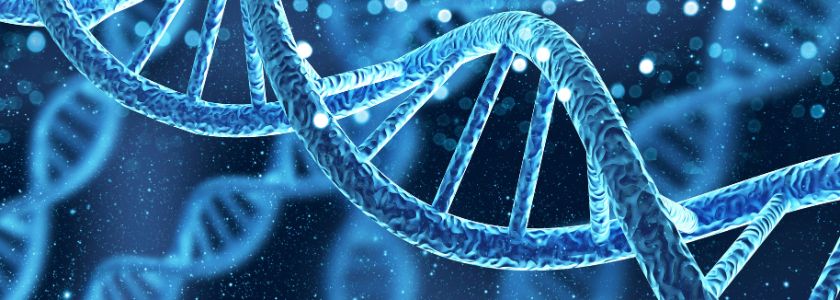Leveraging digital droplet PCR (ddPCR) for accurate quantification of amplifiable DNA

The Takeaway: Accurate quantification of amplifiable DNA is crucial for various applications, including next generation sequencing, gene expression analysis, and forensic investigations. Traditional quantitative PCR (qPCR) methods are widely used, but they often face challenges such as amplification bias and inaccuracies in low-abundance samples. Digital droplet PCR (ddPCR) is a powerful alternative and provides precise quantification of target DNA molecules.
Understanding the basics of ddPCR
Digital droplet PCR is a technology that partitions a DNA sample into thousands of individual droplets, each containing a reaction mixture. This technique provides an absolute quantification of DNA molecules, overcoming the limitations of qPCR. Here are the basic steps involved in ddPCR:
Sample partitioning: The DNA sample is mixed with a PCR master mix to create droplets. Each droplet acts as a separate reaction vessel.
Amplification: PCR amplification occurs within each droplet independently. Positive and negative droplets are generated based on the presence or absence of the target DNA.
Detection: After PCR, droplets are analyzed using a fluorescence detector. Positive droplets emit fluorescence, allowing quantification of the target DNA.
How to design a ddPCR experiment
Primer and probe design: Design specific primers and probes targeting the region of interest. Probes should be labeled with fluorescent dyes for detection.
Optimizing reaction conditions: Determine optimal annealing temperature, primer concentrations, and PCR conditions. Use positive and negative controls to validate the assay.
Sample preparation: Extract high-quality DNA to ensure accurate quantification. Avoid DNA degradation and contaminants that may impact ddPCR results.
How to perform a ddPCR experiment
Setting up the reaction: Combine DNA samples with the PCR master mix. Carefully load the reaction mix into the droplet generator.
Droplet generation: Employ a droplet generator to create uniform droplets. Optimize droplet generation conditions for consistency.
Thermal cycling: Conduct PCR amplification with optimized cycling conditions. Ensure sufficient amplification without saturation.
Data analysis: Analyze droplet data using dedicated software. Determine the number of positive and negative droplets for each sample.
How to quantify amplifiable DNA
Absolute quantification: Calculate the concentration of the target DNA based on the number of positive droplets. ddPCR provides an absolute quantification without the need for standard curves.
Limit of detection and quantification: Assess the limit of detection and quantification for your assay. Understand the sensitivity of ddPCR in detecting low-abundance DNA.
Advantages of ddPCR in DNA quantification
- Improved precision: The digital nature of ddPCR eliminates the variability associated with qPCR and permits higher precision in quantifying rare or low-abundance DNA.
- Reduced amplification bias: Overcomes PCR bias by individually amplifying each molecule. Provides accurate results even in the presence of inhibitors.
- Absolute quantification: No reliance on external standards or calibration curves. Facilitates direct comparison of DNA concentrations between samples.
Applications of ddPCR in research
- Gene expression analysis: Accurate quantification of gene expression levels. Detection of subtle changes in gene expression.
- Cancer research: Precise quantification of circulating tumor DNA. Monitoring cancer progression and treatment response.
- Environmental DNA (eDNA): Quantifying DNA from environmental samples. Assessing biodiversity and ecological studies.
- Forensic investigations: Quantification of trace DNA for forensic applications. Improved sensitivity in identifying perpetrators.
Troubleshooting ddPCR experiments
- Droplet quality: Assess droplet quality using fluorescence microscopy. Troubleshoot issues related to droplet uniformity.
- Assay specificity: Confirm assay specificity using controls and validation experiments. Address potential cross-reactivity or non-specific amplification.
- Sample quality: Ensure high-quality DNA to avoid contaminants and degradation. Verify DNA integrity through gel electrophoresis or other methods.
What is the future of ddPCR in DNA quantification?
Integration with next generation sequencing (NGS): Combining ddPCR with NGS for comprehensive genomic analysis. Enhancing accuracy in variant detection and genotyping.
Advancements in automation: Streamlining ddPCR workflows through automation. Increasing throughput for high-throughput applications.
Single-cell analysis: Adapting ddPCR for single-cell DNA analysis. Unraveling heterogeneity in complex biological samples.
Digital droplet PCR represents a paradigm shift in DNA quantification, offering unparalleled accuracy and sensitivity. Researchers can harness the power of ddPCR for various applications, from basic research to clinical diagnostics. By understanding the fundamental principles, optimizing experimental conditions, and interpreting results accurately, scientists can leverage ddPCR to advance their understanding of the intricacies of amplifiable DNA. As technology continues to evolve, ddPCR is poised to play a pivotal role in shaping the future of molecular biology and genomics.
